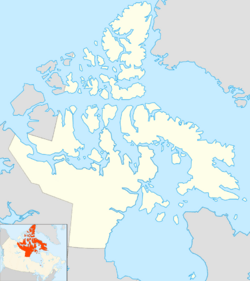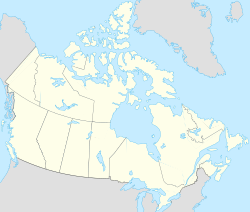Seymour Island (Nunavut) facts for kids
| Geography | |
|---|---|
| Location | Northern Canada |
| Coordinates | 76°48′04″N 101°16′08″W / 76.80111°N 101.26889°W |
| Archipelago | Queen Elizabeth Islands Canadian Arctic Archipelago |
| Area | 2 km2 (0.77 sq mi) |
| Highest elevation | 28 m (92 ft) |
| Administration | |
|
Canada
|
|
| Territory | Nunavut |
| Region | Qikiqtaaluk |
| Demographics | |
| Population | Uninhabited |
Seymour Island is a small, uninhabited island in the far north of Canada. It is part of the Nunavut territory, which is a large area mostly covered by ice and tundra. This island is one of the Berkeley Islands group. It sits about 30 miles (48 km) north of Bathurst Island. Nearby, about 90 km (56 mi) to the east, is Penny Strait. Here, you can sometimes find areas of open water called polynyas, even when the rest of the sea is frozen.
Contents
Discovering Seymour Island
Europeans first saw Seymour Island around 1858. They were on a search for a lost expedition led by Sir John Franklin. An explorer's ship sailed past the island but did not land. They described it as a "long, low reef" about 100 feet (30 meters) high. The island was named after one of the ship's crew members.
The first time people likely visited the island was in the late 1940s. This was when the Canadian Army was surveying and mapping the Arctic islands. During this time, a special metal marker was placed on the island's highest point, which is now called Triangle Point.
In the early 1970s, some fuel drums were left on the island, possibly by an oil exploration company. They were never picked up. Then, in the summer of 1973, something very important was discovered. A scientist named Stewart D. Macdonald found that Seymour Island was the first known place in North America where endangered ivory gulls nested permanently. This made the island very special for wildlife.
Island Features and Weather
Seymour Island is quite small, less than 3 km (1.9 mi) long and 1 km (0.62 mi) wide. It rises about 28 meters (92 ft) above sea level. The island's total area is about 2 square kilometers (0.77 sq mi).
The island has interesting features like "raised beaches." These are old shorelines that are now higher than the current sea level. You can also find large rocks left behind by glaciers, called "glacial erratics." There are also sand bars, gravel ridges, and small freshwater ponds. Water from underground, called "permafrost springs," also flows here. A small piece of fossil coral has even been found on the main ridge.
Even though there are open water areas nearby, Seymour Island is usually surrounded by ice all year. Snow starts to melt in June, but some snow can stay on the island until July. Freshwater ponds can begin to freeze again in late August. Summer weather is often foggy, with temperatures just above freezing. In the mid-1970s, the coldest winter temperature recorded was -58°C (-72°F). The warmest summer temperature was 10°C (50°F).
Animals and Plants
From 1974 to 1977, the Canadian National Museum of Natural Sciences set up a research station on Seymour Island. Biologists studied the endangered ivory gull and collected lots of information about other wildlife and the weather.
Plants on the Island
The island does not have many plants. Most of the plant life is made up of mosses and lichens. Only seven types of vascular plants (plants with roots, stems, and leaves) have been found. The most common one is the purple saxifrage.
Animals on the Island
Seymour Island is visited by polar bears. Less often, you might see Arctic wolves and Arctic foxes. There is a small group of collared lemmings living on the island. Peary caribou have also been seen. In 1974, a Peary caribou killed by Arctic wolves was found. In 1977, a group of seven Peary caribou was seen on nearby Helena Island.
Ringed seals are common on the ice around the island. Up to 100 seals have been seen resting near Seymour Island. Bearded seals also visit sometimes. A skeleton of a beluga whale was found on the southwest coast, far from the current water line. The ocean around the island has Arctic cod, lion's mane jellyfish, and a type of shrimp. A piece of what might be bowhead whale baleen (a filter-feeding plate) was found in an ivory gull nest in 1976. Old wood found on a beach ridge was carbon-dated to be 3,200 years old.
Special Birds: Ivory Gulls
Many birds nest on Seymour Island. These include red-throated loons, king and common eiders, long-tailed ducks, brant gooses, Arctic terns, purple sandpipers, and snow buntings. Other birds that visit are Ross's gulls, black-legged kittiwakes, murres, snowy owls, parasitic jaegers, long-tailed jaegers, pomarine jaegers, and common ravens. Thayer's gulls and glaucous gulls are also found here.
However, Seymour Island is most famous for its ivory gulls. These gulls are found on the island from May to September. In the mid-1970s, 233 pairs of ivory gulls were recorded nesting here. Many non-breeding gulls also visited, sometimes up to 200. In July 1976, three ivory gulls that had been marked on Seymour Island were seen 1,000 km (620 mi) southeast on Prince Leopold Island just three weeks later.
The ivory gulls on Seymour Island build their nests on raised rocky beaches. This is different from other Canadian ivory gull colonies. Seymour Island has Canada's largest known breeding colony of ivory gulls. It is home to about 10–12 percent of all known Canadian ivory gulls. In 2005, scientists thought that the gulls on Seymour Island might make up 40 percent of the remaining Canadian population of this species. The Seymour Island population is also about one percent of the world's total ivory gull population.
Protected Areas
To protect the important wildlife, the Seymour Island Migratory Bird Sanctuary was created in 1975. This protected area covers 2,800 hectares (6,900 acres), including the island and the waters around it. This sanctuary is also part of the Seymour Island Important Bird Area (No. NU045). The island is also recognized as an International Biological Programme Site (No. 1-7) and a Key Marine Habitat Site in Nunavut (No. 2). These titles show how important Seymour Island is for nature and wildlife conservation.



